Luis Urías doesn’t swing much. In parts of four seasons since debuting, Urías has a swing rate of 41.5%, a swinging strike rate of 8.5%, and has decreased both in every consecutive season. Is that passive an approach working? Does it limit the impact of his strong contact ability? These questions are nothing new for hitters like Urías.
Evaluators have lauded his plate discipline since the Padres signed him out of Mexico in 2013. His extensive minor league track record includes four consecutive seasons with more walks than strikeouts and an overall K:BB ratio of 306:256. In 2021, Urías has shown more of the same (13 Ks: 12 BBs), but his approach has an interesting place amongst major league hitters.
Visualizing an Approach
Most players can hit a pitch in the strike zone. It’s sort of a prerequisite of being a major league hitter. Unsurprisingly, hitters make contact with most of the strikes they swing at — but some swing less than others:
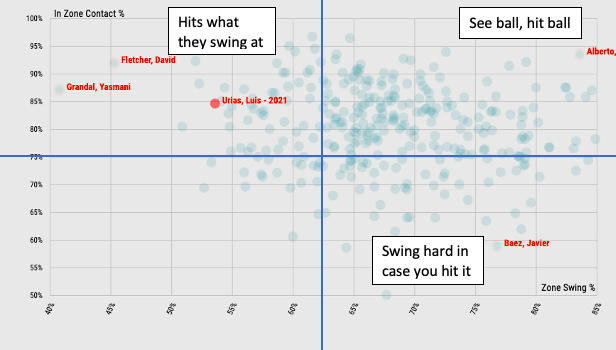
Urías has the 8th-lowest Zone Swing% in the majors but makes fairly consistent contact when he does swing. That combination puts him in the vicinity of David Fletcher’s high-contact approach and Yasmani Grandal’s swing-at-nothing approach. But what about pitches outside the zone?
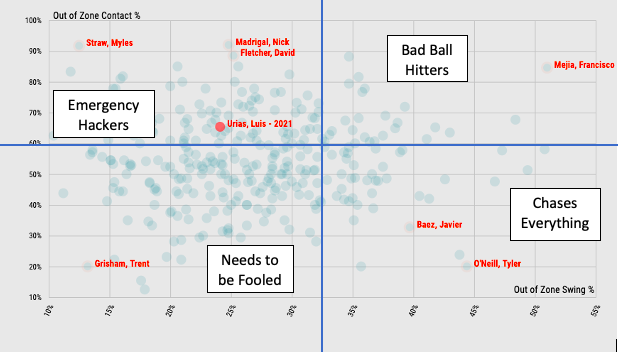
Notice the outliers here. In the bottom right we see the likes of Javier Baez and Tyler O’Neil, who might as well step up guessing. In the top right, we see “bad ball hitters” like Francisco Mejia, whose premium contact skills can mask sub-par pitch recognition. In the bottom left are the hitters who successfully lay off pitches they can’t hit (oh look, it’s Trent Grisham). Then comes the top left — hitters who pair contact skills with pitch recognition. Urías’s skillset fits, but not nearly to the extreme of high-contact fiends like Fletcher and Nick Madrigal. Put together, we can order the approaches from passive to aggressive.
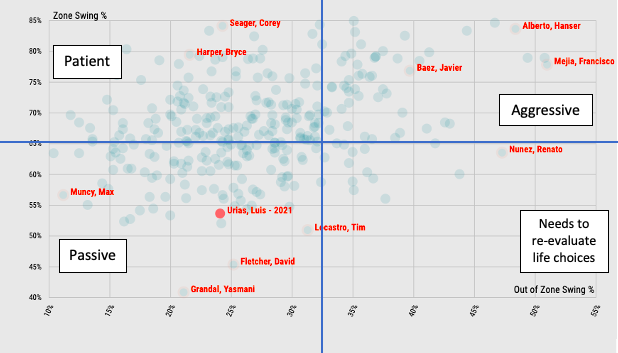
This chart ignores contact ability but should be a strong indication of pitch recognition ability. In the top right, we have the free-swingers; Pitch location doesn’t matter, they will swing whether they make contact or not. In the bottom left we have the opposite; hitters who successfully lay off balls, but give up a few strikes as a result. The top left is where most hitters live; Swing at strikes, lay off balls. It’s simple.
Urías’ approach is certainly on the more passive side, but he also doesn’t get many pitches to hit. His 47% Zone% ranks 211th in the majors and likely a result of hitting 8th in a National League lineup. That said, his ability to recognize (and swing at) good pitches is promising and could pay dividends if given more pitches to hit.
Mechanical Adjustments
Paired with his advanced feel for contact, Urías continued to rise through the Padres system as a hitter with advanced tools for his age. He debuted in 2018 as a 21-year-old on the heels of an uncharacteristic season at Triple-A El Paso. Going into 2018, Urías changed his approach to add power. He will never be a true power hitter, but the Padres made a concerted effort to squeeze every bit of power out of Urías’ 5’9″ frame. You may even recognize his high leg kick, which bears a striking resemblance to a similarly built hitter.
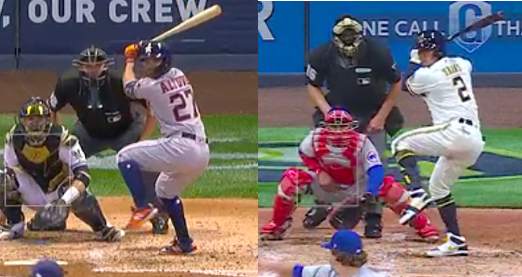
Urías’ swing is nearly identical to Jose Altuve — who has shown the ability to hit for power throughout his career. Of course, strength and overall ability are involved, but it doesn’t seem like Urías’ power is completely held back by mechanics. Altuve’s two-strike approach is much different though — he drops the leg kick almost entirely in favor of a quicker toe-tap. Prior to 2018, Urías did the exact same thing but has kept the leg kick with two strikes since. The approach change led to that aforementioned season in El Paso, where he set career highs in HR (8), 2B (30), and SLG (.447) but also had more strikeouts than walks for the first time in his career (109 Ks, 67 BBs).
Urías was traded Milwaukee prior to the 2020 season in a deal that looks pretty lopsided as things currently stand, but the Brewers obviously see upside in Urías and have continued to tinker with him to unlock that potential.
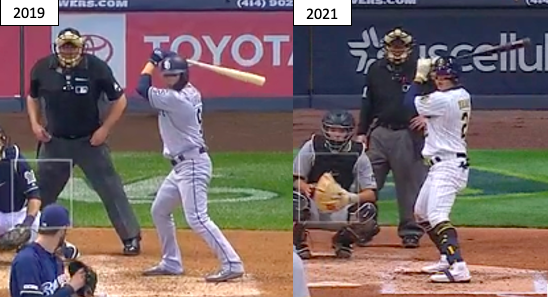
His changes show an effort to simplify a swing with a ton of moving parts. For one, Urías had a wide-open stance when he debuted in 2019 and has slowly closed it every year since. This season represents the biggest change, as his feet are nearly even now. He is obviously comfortable with the high leg kick, as it has remained the same despite the stance changes. Urías has also lowered his hand placement, allowing for a quicker load. His past load was very inefficient, with the leg kick and high hands coiling together to create a disjointed and unbalanced swing. The lower hands allow him to load quickly and controllably without ditching the leg kick.
Looking Ahead
It’s worth noting that Urías’ 2020 season should be taken with a grain of salt. It began with a broken wrist in winter ball and was delayed even further by a positive COVID-19 test. Though he still managed to appear in 41 games, it’s fair to assume health played a role in his lackluster results.
There are still negatives to his profile. He still doesn’t hit the ball particularly hard (which is mildly concerning given that exit velocity is up league-wide), his sprint speed is pretty low for someone with his skillset (52nd percentile), and he probably shouldn’t be playing shortstop long-term. That being said, Urías is still just 23 years-old, has a promising combination of pitch recognition and contact skills, and is poised to see plenty of playing time. If he can continue to identify pitches to hit and the mechanical tweaks unlock some power, I am optimistic he can reach the 10-15 HR mark in the near future. He’s hit a pair of homers already this season, 5 of his 7 hits have gone for extra bases, and he’s still walking at a 23% clip. With just a bit more power, Urías has all the makings of an above-average major league regular.
Photos by Bryce Edwards/Flickr & Keith Gillett/Icon Sportswire | Adapted by Justin Redler (@reldernitsuj on Twitter)

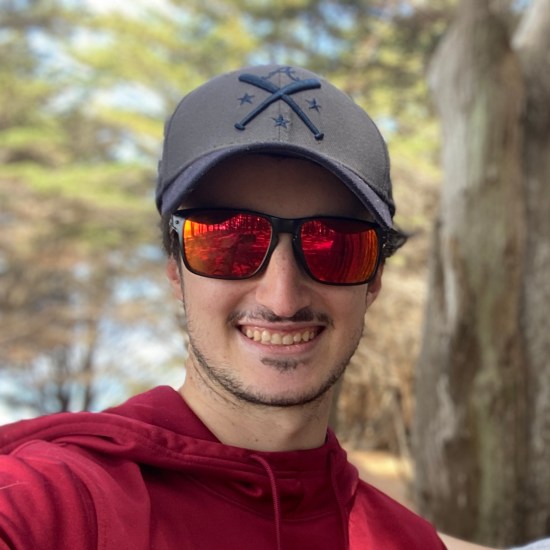
Great article. I think Urias has a lot of potential. I also think his defensive prowess at SS is underrated – not tremendous range, but above average with an excellent glove and a solid arm.